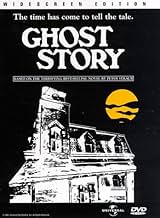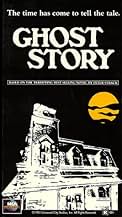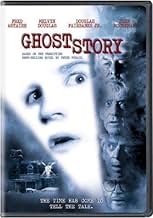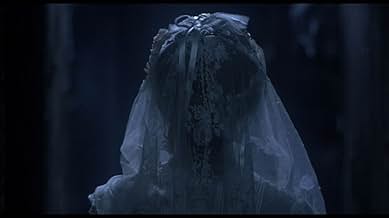Two generations of men find themselves haunted by the presence of a spectral woman. When the son of one of the elderly men returns to his hometown after his brother's mysterious death, they ... Read allTwo generations of men find themselves haunted by the presence of a spectral woman. When the son of one of the elderly men returns to his hometown after his brother's mysterious death, they attempt to unravel her story.Two generations of men find themselves haunted by the presence of a spectral woman. When the son of one of the elderly men returns to his hometown after his brother's mysterious death, they attempt to unravel her story.
- Awards
- 3 nominations total
- Director
- Writers
- All cast & crew
- Production, box office & more at IMDbPro
Storyline
Did you know
- TriviaFinal theatrical feature film of veteran actors Melvyn Douglas, Fred Astaire, and Douglas Fairbanks Jr.
- GoofsRobert Burr is credited as " Principal ". Since the school in the film is a college, his title in the credits should be " Dean ".
- Alternate versionsThe Australian theatrical version was cut to receive a more commercial 'M' rating (all ages admitted but recommend for 15 and over) rather then an 'R' rating (restricted to 18 years and over).
- SoundtracksSweetheart of Sigma Chi
Written by F. Dudleigh Vernor and Byron D. Stokes
Performed by Guy Lombardo and The Royal Canadians (as His Royal Canadians)
Featured review
... with a fantastic cast of veterans - Fred Astaire, John Houseman, Melvyn Douglas, Douglas Fairbanks Jr, and Patricia Neal. Unfortunately, the film always keeps getting in the way, leaving the veterans with scant onscreen attention.
The tale concerns a group of men, haunted by a death they were all accidentally responsible for in the early 1930s, and what happens when the ghost of that victim (Alice Krige) returns for vengeance, resulting in a lot of men shocked to death and abrupt shock cuts that show a rotting corpse in place of Krige's face. Unfortunately, maybe because of studio interference, the majority of screentime goes to Craig Wasson as a pair of Fairbanks' identical twin sons, one ill-fated very early on, the other more successful in surviving. Frankly put, although he isn't bad in the film, it feels like false advertising. (Wasson also has to have one of the tackiest death scenes in cinema history as the ill-fated brother who, terrified by Krige's skeletal look after a night of sex, plunges backwards stark naked from a high-rise window, as the film shows him against a badly processed back projection flailing his arms about, while his private parts flutters every which way like a Planters peanut caught in a strong wind). There's a reason Krige goes after the next generation in the case of Fairbanks' sons, but you'll have to watch and find out what that reason is.
So, Astaire and all the others I came to see are left with mere onscreen scraps, and are left with unformed characterizations. That feels like a grave betrayal for this classic film fan, especially in the light that it was the final film for Astaire, Douglas, and Fairbanks.
There were some particularly well-done parts though. For one Alice Krige was perfect for her part because her porcelain doll looks make her appear to be somebody out of an earlier time. Winter in the New England town the veteran actors live in has the look of a place that's haunted - it's very atmospheric. And finally, the film points out how having a crisis at 20 rather than 30 makes all the difference in the world as to the calmness and wisdom with which that crisis is handled.
The tale concerns a group of men, haunted by a death they were all accidentally responsible for in the early 1930s, and what happens when the ghost of that victim (Alice Krige) returns for vengeance, resulting in a lot of men shocked to death and abrupt shock cuts that show a rotting corpse in place of Krige's face. Unfortunately, maybe because of studio interference, the majority of screentime goes to Craig Wasson as a pair of Fairbanks' identical twin sons, one ill-fated very early on, the other more successful in surviving. Frankly put, although he isn't bad in the film, it feels like false advertising. (Wasson also has to have one of the tackiest death scenes in cinema history as the ill-fated brother who, terrified by Krige's skeletal look after a night of sex, plunges backwards stark naked from a high-rise window, as the film shows him against a badly processed back projection flailing his arms about, while his private parts flutters every which way like a Planters peanut caught in a strong wind). There's a reason Krige goes after the next generation in the case of Fairbanks' sons, but you'll have to watch and find out what that reason is.
So, Astaire and all the others I came to see are left with mere onscreen scraps, and are left with unformed characterizations. That feels like a grave betrayal for this classic film fan, especially in the light that it was the final film for Astaire, Douglas, and Fairbanks.
There were some particularly well-done parts though. For one Alice Krige was perfect for her part because her porcelain doll looks make her appear to be somebody out of an earlier time. Winter in the New England town the veteran actors live in has the look of a place that's haunted - it's very atmospheric. And finally, the film points out how having a crisis at 20 rather than 30 makes all the difference in the world as to the calmness and wisdom with which that crisis is handled.
Details
Box office
- Budget
- $13,500,000 (estimated)
- Gross US & Canada
- $23,371,905
- Opening weekend US & Canada
- $2,105,729
- Dec 20, 1981
- Gross worldwide
- $23,371,905
- Runtime1 hour 50 minutes
- Sound mix
- Aspect ratio
- 1.33 : 1(original ratio, open matte)
Contribute to this page
Suggest an edit or add missing content









































